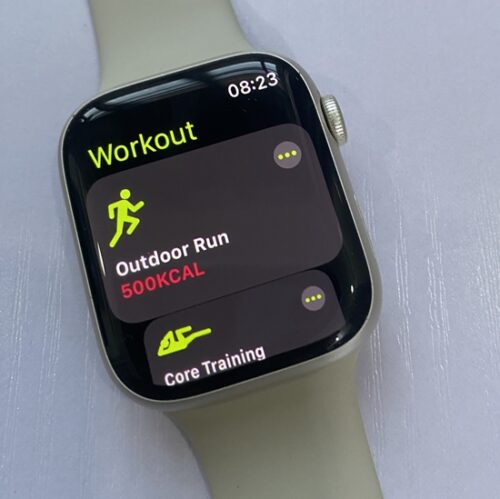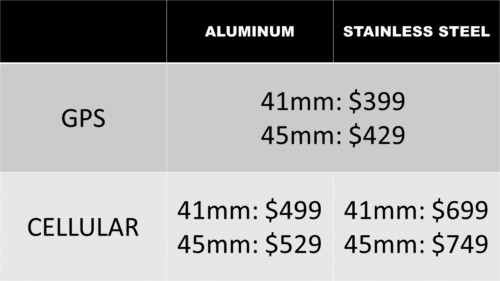The Apple Watch Series 8 is the successor to last year’s Apple Watch Series 7. It was recently released alongside the Apple Watch Ultra and Watch SE 2 and it welcomes a few interesting features. The Watch 8 like its predecessor comes in two sizes; 41mm and 45mm and each of these sizes is available in GPS and Cellular models. So in this post, we’ll look at the differences between the cellular and GPS models to help you understand which is a better choice for you.
Apple Watch Series 7 vs 8 Full Specifications Comparison
[table id=001 column_order=manual column_order_manual_order=”A,XJ,XL” /]
Apple Watch Series 7 vs 8 – What’s New?

Before we talk about the difference between the GPS and Cellular models of the Watch 8 let’s take a look at what’s new to the Watch 8 so that you decide if an upgrade is a worthwhile investment. In all honesty, I don’t see that enticing feature that makes the Watch 8 a worthy upgrade. To me, the Watch 8 seems like a revamped Watch 7.
The Watch 8 has the same appearance and dimension as the Watch 7. It also has the same storage capacity and health-tracking features as its predecessor. All the features in WatchOS 9 are available on the Watch 7 except a few additional features.
So in all ramifications, the Watch 8 is basically a revamped Watch 7 with a new price tag. Though there are a few additions which are listed below.
- Watch 8 is available in two materials
- Watch 8 has a temperature sensor
- Watch 8 has a higher Bluetooth version
- Frequency of heart rate tracking reduced during a workout
Unlike the Watch 7 which is available in aluminum, stainless steel and titanium, the Watch 8 only comes in aluminum and stainless steel. Seems Apple has decided to reserve the titanium build for the more advanced Apple Watch Ultra.
2. Watch 8 features crash detection
While the Watch 7 has a 32-g accelerometer, the Watch 8 has a more powerful 256-g accelerometer that can detect when a car has crashed. This feature can come in handy for you if you own a car. It’s an addition to the incidental fall detection feature that lets the watch start a call to an emergency contact when it detects a fall and the user is unresponsive for 60 seconds.
One of the main additions to the Watch 8 is the presence of a temperature sensor. This is also the main addition to the Samsung Galaxy Watch 5. With a temperature sensor in Watch 8 and Ultra, both watches can monitor skin temperature changes and can also estimate the ovulation cycle for women.
This might not be a significant difference, however, the Watch 8 has a higher Bluetooth version 5.3 compared to v5.0 on the Watch 7. The higher version ensures better connectivity, easier switching between different cycles, and by extension improved battery life.
WatchOS 9.1 is available for the Apple Watch Series 4 up to 7, however only Watch 8, Watch Ultra and Watch SE 2 will reduce the frequency of heart rate tracking and GPS readings during a workout. Thus, reducing the impact on battery life.
Those are what you get on the Watch 8 but are not available on Watch 7.
Apple Watch Series 8 GPS vs Cellular – The Difference
[table id=001 column_order=manual column_order_manual_order=”A,XL,XM” /]
Now that you know what’s new in Watch 8, let’s take a look at the differences between the GPS and Cellular models to ensure you get what you really need.
- Cellular model is a standalone smartwatch
- GPS model is only available in aluminum build
- Only the Cellular model supports Family Setup
- GPS model is cheaper
- Cellular model requires a subscription
The main factor that separates the GPS model from the Cellular model is the presence of an eSIM in the latter. This will enable cellular connectivity that allows you to receive and reply to messages and make and receive calls without connecting to your iPhone. That is, you don’t need your iPhone nearby to make calls with the Cellular model. However, with the GPS model, you can do all of these, but your iPhone must be nearby.

Worthy of note is that with WatchOS 9, you now have separate switches for cellular and cellular data. For instance, if you want to download an app, and there’s no WiFi network available, you can turn on cellular data to do that. And when you done, you simply turn it off while still being able to make and receive calls. This is an important feature that can help conserve the battery life of the cellular model.
The GPS model is limited to only aluminum build. If you wish to get the cellular model, then you can choose from stainless steel or aluminum build. Note that the stainless steel model is more expensive.
For family members who don’t own an iPhone, Family setup will allow you setup an Apple Watch for that member and they would be able to enjoy all of its features. However, Family setup is available for only the Cellular model.

As a result of the standalone capabilities of the cellular model, it retails at a higher price than the GPS model. The 45mm GPS model of the aluminum build retails for $429 while the 45mm cellular retails for $529.
You will also need to pay a subscription fee for the cellular plan on the Apple Watch cellular model. This is an additional cost to factor in before deciding to settle for the cellular model.
Bottom line, the Cellular model gives you more freedom from your iPhone.
Apple Watch Series 8 41mm vs 45mm
Like its predecessor, the Watch 7, the Watch 8 is available in 41mm and 45mm sizes. So it’s important you also know the differences between the two sizes to help you land the right size that will seat beautifully on your wrist.
The 41mm and 45mm sizes are the same. It’s the same design, battery life, storage, health tracking features and more. The only difference between these two is the display size, dimension, and price.
- Dimension and weight
- Display size
- Price
Though both sizes are very compact and lightweight, the 41mm unit being smaller is more compact than the 45mm unit. It has a 41 x 35 x 10.7mm dimension while the 45mm unit has a 45 x 38 x10.7mm dimension. The 41mm size also weighs a little less than the 45mm unit.
Due to its bigger size, the 45mm unit has a larger display size than the 41mm unit. It has a 1.92 inches display size while the 41mm unit has a 1.69 inches display. Both are powered by LTPO OLED with brightness up to 1000nits.

The 45mm unit will cost you more thanks to its bigger display that allows you to see more at a glance.
Apple Watch Series 8 vs Watch Ultra
Apple raised eyebrows among tech pundits and their competitors with the release of the Watch Ultra. The Watch Ultra is the most advanced Apple Watch with lots of outdoor workout features that makes it a direct competitor to Garmin watches.
It comes in a more durable titanium build with a design that separates it from every other Apple watch. The Watch Ultra is only available in the Cellular model, so it’s important to know how it differs from the Watch 8 just in case you decide to settle for the cellular model.
While its appearance is different from the Watch 8, both watches share a lot of features in common except for the differences mentioned below.
- Watch Ultra is more durable
- Watch 8 is more compact and slimmer
- Watch Ultra has a brighter display
- Watch Ultra has a water temperature sensor
- Watch Ultra is dive ready
- Watch Ultra has dual speakers
- Watch Ultra has dual-band GPS
- Watch Ultra has a longer battery life
While the Watch 8 is a very durable device, the Watch Ultra is even more durable. It comes in a titanium build with a flat screen surrounded by a slightly raised bezel that helps protect the sapphire glass screen. Moreover, the digital crown and flat button are protected and it has a new action button on the left side that makes it easier to access.
Furthermore, the Watch Ultra is rated 10ATM which means it’s water resistant up to 100 meters – it’s the first Apple Watch to have this rating. It backs it up with a MIL-STD-810H rating that certifies that it can withstand certain harsh weather conditions.
Meanwhile, the Watch 8 comes in aluminum and stainless steel with the latter having a sapphire glass screen while the former has an ion-x glass screen. The display is flat but curved at the edges while the digital crown isn’t protected. The Watch 8 has a 5ATM rating.
Perhaps the price to pay for the longer battery life and protection is a bigger case size. The Watch Ultra is quite bulky at 49mm and also thick at 14.4mm. The Watch 8 is more compact and slimmer at 10.7mm.
While both watches are powered by the same LTPO OLED, Watch Ultra has a brighter display maxing out at 2000nits compared to the 1000nits of Watch 8.
Although both watches have a skin temperature sensor, the Watch Ultra gets an additional water temperature sensor that allows it to monitor water temperature.
As a result of the 10ATM rating and other factors, the Watch Ultra is dive ready. It comes with a dive app that can show your depth in water as well as the water temperature. Moreover, there is now an Oceanic+ app that can turn the Watch Ultra into a dive computer with its host of intuitive features (contains premium features).
While there is a speaker in both watches, the Watch Ultra has a louder speaker thanks to its dual-packed speakers. The dual speaker supports its siren feature which Apple claims can attract attention with its 89db noise level.
Though both watches have inbuilt GPS, the Watch Ultra has dual L1 and L5 GPS sensors. The dual-band GPS of the Watch Ultra improves its route mapping and outdoor activity tracking accuracy. The Garmin Fenix 7 also has a dual-band GPS.
To cap it off, the Watch Ultra has a longer battery life than Watch 8. You can get up to 36hrs with Watch Ultra compared to 18hrs with Watch 8. And when the battery saver mode is activated, it’s up to 60hrs with Watch Ultra and 36hrs with Watch 8. Both watches support fast charging and it takes less than an hour to fully charge.
So that’s the difference between the Watch Ultra and Watch 8. Clearly, the Watch Ultra is more durable and advanced.
GPS or Cellular model – Which do you need?
In a few words, if you have a low budget, go for the GPS model. It has the same features as the cellular model just that you will need your phone nearby to make and receive calls as well as receive and reply to messages. With the GPS model you don’t need your iPhone to download music, stream music, or download watch faces and apps from the app store, you only need Wi-Fi.
On the hand, the cellular model is the best choice for kids, seniors, and anyone who’s nature of job keeps them away from their phone. Also, get the cellular model if you do a lot of outdoor workouts, carrying your phone along can come with its own inconveniences, especially for runners and hikers.


